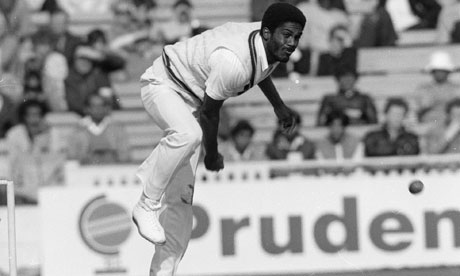
Last winter, by chance, I found myself travelling to Australia with Viv Richards, who was on his way to do some "King and I"-type gigs with Rodney Hogg, the former Australian fast bowler. We've known each other a long time, Viv and I, but I'd never got round to asking him one particular question. So I did.
"If you had to choose four fast bowlers of your time with West Indies, which would they be?" He replied: "Well, I would have Malcolm. And I would have Andy. And I would have Mikey." He pondered a little longer. "And I would have Curtly." So there you have it, Viv Richards' dream attack: Malcolm Marshall, the slithering genius; Andy Roberts, cerebral, calculating, the Godfather of the modern West Indian pacemen; Michael Holding, Ferrari or Rolls Royce, and possibly the most beautiful athlete to grace a cricket field; and Curtly Ambrose, surging relentlessly in. Look at the paucity around the world today, and understand what daunting really means.
The four never played together, of course, but consider those who failed to make Viv's list. Take, for example, that photograph, snapped in 1981 in Port of Spain, of arguably the most chilling pace quartet of them all, standing, arms folded and unsmiling, in echelon, in height order: first Roberts to the fore; then Holding; next Colin Croft, the smiling assassin who, he once said, would bounce the crap out of his grandmother if it meant a wicket; and the Big Bird, Joel Garner, gentle and jovial in reality, who could pepper your rib cage or bust your foot with equal felicity. Neither Croft nor Garner got on to Viv's list. Nor did Patrick Patterson, the only man to make Graham Gooch genuinely fear for his well-being; nor the faithful, indefatigable Courtney Walsh who took more wickets than any of them. Sylvester Clarke, considered the nastiest of the lot, scarcely got a game for West Indies and neither did Middlesex's Diamond, Wayne Daniel. Both would walk into any other international team of the past three decades. Such times of plenty and never to be seen again.
Holding, Roberts and Garner were among those who attended Monday's premiere of Fire In Babylon, the sociodocumentary that tells the story of West Indies' rise to dominance in the second part of the 1970s, and through the decade that followed, and what it meant to the region. I did an interview for the movie while in Antigua, but like others who witnessed it at first hand but are not from West Indies, it did not make the final cut. Instead, the director chose to tell the story through West Indian eyes, which is understandable, but a pity as well because there are those who could place into perspective what it was like to face these bowlers for a living ("Dying ain't much of a living," as the Outlaw Josey Wales said), and what was in the mind, not least in those days before helmets offered some protection from the most serious of injuries.
So, to redress the balance, I can try to convey how a tail-end batsman, without the requisite skills or indeed reactions, of the more celebrated willow-wielders, coped, or more often than not, failed to cope. I can say, without fear of contradiction, that never in my life had I played in a match with a bowler as swift as Holding. From the Old Trafford dressing room, side on to play, it was almost impossible to follow the flight of the ball from hand to the gloves of Deryck Murray. And it was this that I walked out to face. Holding was bowling from the Warwick Road End, and as I took guard was standing at the start of his run, in a different postcode. As was keeper and ring of slip fielders. I imagine there was a short-leg (for the life of me I cannot remember) but that apart it was a lonely place, the non-striker the nearest point of human contact.
It was not until other occasions that I realised the trick was not to focus on Holding until he was actually approaching the crease. For now, in the distance, I saw him duck his head in that way a thoroughbred might on the Newmarket gallops that he inhabits now whenever he can, and begin his majestic run. It was mesmerising, for as he strode, Holding's head, held high, swivelled slightly from side to side. The cobra, I am told, hypnotises prey in a similar swaying manner.
He reached the crease, and the ball flew from his hand. A split second later, the ball exploded from the middle of my bat and ricocheted (there is no other word for it) back past the bowler, and we scampered two runs. It even drew some applause. The thing was, here was a bowler of such purity that you never lost sight of the ball, yet who could propel it at such velocity that although in vision all the time, it was too fast for the reaction of someone of my capabilities. And that is the most chilling part of all.

